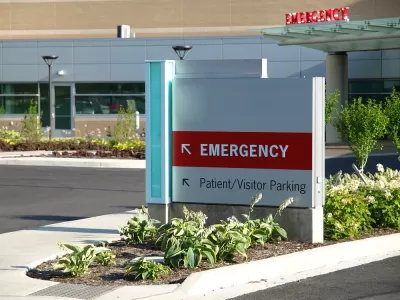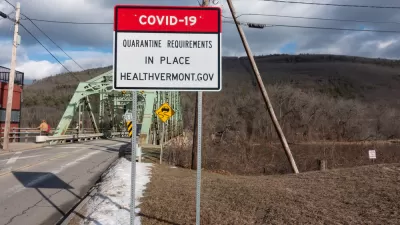Infections from the Omicron variant, which early studies suggest cause less severe illness than the Delta variant, may be contributing to a record number of hospitalizations in Ohio, the highest since the start of the pandemic.

"Public health leaders are increasingly recommending focusing on COVID-19 hospitalizations instead of cases to steer public health guidance," write Gabrielle Masson and Georgina Gonzalez for Becker's Hospital Review on January 3.
Former FDA Commissioner Scott Gottilieb, MD, centered the role of hospitals in assessing the severity of the omicron variant. He told CBS Jan. 2 that "there's a very clear decoupling between cases and hospitalizations."
[Ashish Jha, dean of the Brown School of Public Health, said much the same thing in the related post: "Your Date With Omicron," Dec. 29, under the header, Two health metrics to watch closely.]
Gottlieb added that it "does appear now based on a lot of experimental evidence that we've gotten just in the last two weeks, that this is a milder form of the coronavirus appears to be a more of an upper airway disease [than] a lower airway disease; that's good for most Americans."
Anthony Fauci, MD, director of the National Institute of Allergy and Infectious Diseases, echoed Dr. Gottlieb's view.
"As you get further on and the infections become less severe, it is much more relevant to focus on the hospitalizations as opposed to the total number of cases," Dr. Fauci said on ABC Jan. 2. He warned, however, of the potential strain hospitalizations could place on health professionals and health systems across the nation.
Ohio sets pandemic hospitalization record
Fauci could have pointed to Ohio, although it's not clear to this correspondent how much Omicron is to blame for the strain on the state's health care system.
The announcement that the number of people hospitalized in Ohio had set a record was made by the governor last Wednesday, along with the mobilization of help to assist beleaguered hospitals.
"Ohio Governor Mike DeWine [R] announced today that he has ordered the mobilization of an additional 1,250 members of the Ohio National Guard to support hospitals with the most critical needs across the state," states the Dec. 29, 2021 press release. "The mobilization comes on the same day the state set an all-time high for the total number of COVID-19 hospitalizations during the pandemic."
The Ohio Hospital Association reported today that 5,356 people are currently hospitalized with COVID-19. One in four patients are COVID-19 positive. This surpasses the previous hospitalizations record of 5,308 on Dec. 15, 2020. Of today’s hospitalizations, 1,228 patients are in the ICU, which is approaching the record high of 1,318 ICU patients reported on Dec. 15, 2020.
The New York Times coronavirus database for Ohio shows the 7-day average of daily hospitalizations setting a record on New Year's Day with 5,727 hospitalizations, surpassing the record set on Dec. 14, 2021, of a 7-day average of 5,652 hospitalizations.
Ohio's hospital crisis relative to the nation
Ohio, the nation's seventh most populous state (11,700,000 people according to the Covid Act Now database), has the fourth-highest number of patients hospitalized (5,891) with COVID-19 on Jan. 2, according to the Times national coronavirus database, behind N.Y., Texas and California, respectively. Nearly 95,000 Americans are hospitalized with COVID-19 on Jan. 2, a rate of 29 patients per 100,000 Americans, an increase of 37% from 2 weeks ago.
As noted in Monday's post, "Nation's Capital is #1 COVID Hotspot," the District of Columbia has the nation's highest hospitalization rate: 84 patients per 100k residents on Jan. 2. Ohio is #2 with 50 per 100k. However, the District's surge is more recent, an increase of 252% over the last 2 weeks, with the steep increase beginning in mid-December according to the hospitalization graph on the Times' D.C. tracker.
Ohio's increase began in early November, well before Omicron was identified by South African scientists. Furthermore, Ohio's 14-day increase was 15%, well below half the national increase in hospitalizations.
Delta or Omicron?
Karaline Cohen of WSYX (Columbus, Ohio) reported (in the source article) on Gov. DeWine's press conference held on Dec. 29.
“It is clear that Omicron is spreading, and I use the word like wildfire across Europe,” state health director Dr. Bruce Vanderhoff said. “It’s spreading at an incredibly fast pace. Early indicators here in the United States are reaffirming that fast spread.”
Vanderhoff is addressing transmission, not hospitalization. In sharp contrast to being #2 in the hospitalization rate, the case incidence (daily new cases per 100,000 people) is the 12th highest, averaging >17,400 daily cases, nearly 150 daily new cases per 100,000 residents on Jan. 2, according to Covid Act Now and the Times trackers. The nation is averaging >405,000 cases or 122 per 100,000 people.
As posted last week, the nation and the world broke the pandemic record for new infections on Dec. 27, 2021. Every day sets a new record for coronavirus transmission.
David Marcozzi, a professor and physician leading the Covid-19 response for the University of Maryland Medical System, told The Washington Post on Dec. 30 (and posted Monday):
“We’re presently in a perfect storm,” said Marcozzi. "While most people testing positive in recent weeks have been infected by the highly transmissible omicron variant, many of the those winding up in the hospital have the delta variant."
Whatever the relative share of hospitalizations resulting from the two variants , the result is the same – COVID patients overwhelming hospitals, coming at a time when hospitals nationwide are short-staffed.
Dr. Robert Wyllie, representing the Cleveland Clinic at the Columbus press conference last Wednesday with Gov. DeWine and Health Director Vanderhoff, said, “This morning we had the highest number of people out that we’ve had since the pandemic started. Over 2,700 of our workers were out.”
Unvaccinated residents burdening hospitals
Gov. DeWine emphasized that the overwhelming number of COVID patients filling Ohio hospital beds were unvaccinated, adds Cohen of WSYX.
Since June 1, more than 35,000 people have been admitted to Ohio hospitals with COVID-19.
“Of those, 2,687 were fully vaccinated...,” DeWine said. “Which means 92.5% of people in the hospitals have not been vaccinated.”
With 55% of its population fully vaccinated, Ohio is 7 percentage points lower than the national average on Jan. 2, according to the Times tracker.
Masks?
As has been seen in Alaska, Idaho and Colorado during the height of their fall Delta surges when the crisis standards of care were implemented, allowing for the rationing of hospital services, Democratic and Republican governors have been unwilling to issue orders to mitigate transmission, though all have allowed local governments to do so. Louisiana was the exception in that Gov. John Bel Edwards did issue a statewide mask mandate.
DeWine emphasized that there is no mask mandate currently but encouraging mask-wearing to keep kids in the classroom in the new year.
Hospitalizations in other states
Molly Gamble of Becker's Hospital Review reports on January 2 that "COVID-19 hospitalizations up in 34 states."
Hospitalizations for COVID-19 have increased 35 percent nationwide over the past 14 days, according to Health and Human Services data presented by The New York Times.
Nationwide, the seven-day average for COVID-19 hospitalizations was 93,322 as of Jan. 2. That's about 38 percent lower than the pandemic high recorded in January 2021 and 12 percent lower than the peak of the delta wave in late August 2021.
Gamble adds another reason why hospitalizations may be a more important health metric than positive test results to track during the pandemic.
The New Year's holiday caused reporting gaps and backlogs throughout this week for testing, case and death numbers. Hospitalizations are the one data point that is less volatile to holiday slowdowns, given that hospitals do not get holidays off.
Gamble lists the 14-day change for hospitalizations for each state plus the District of Columbia, according to HHS data presented by The New York Times. Seventeen states show a decline in hospitalizations, from Montana (-4%) to Wyoming (–32%).
Related in Planetizen:
- Nation's Capital is #1 COVID Hotspot, Jan. 3, 2022
- The Pandemic Crisis Is a Hospital Crisis, September 23, 2021
-
Another State (Ohio) Gets It Right, April 14, 2020
FULL STORY: Ohio sees highest number of hospitalizations from COVID-19 since pandemic began

Trump Administration Could Effectively End Housing Voucher Program
Federal officials are eyeing major cuts to the Section 8 program that helps millions of low-income households pay rent.

Planetizen Federal Action Tracker
A weekly monitor of how Trump’s orders and actions are impacting planners and planning in America.

Ken Jennings Launches Transit Web Series
The Jeopardy champ wants you to ride public transit.

Crime Continues to Drop on Philly, San Francisco Transit Systems
SEPTA and BART both saw significant declines in violent crime in the first quarter of 2025.

How South LA Green Spaces Power Community Health and Hope
Green spaces like South L.A. Wetlands Park are helping South Los Angeles residents promote healthy lifestyles, build community, and advocate for improvements that reflect local needs in historically underserved neighborhoods.

Sacramento Plans ‘Quick-Build’ Road Safety Projects
The city wants to accelerate small-scale safety improvements that use low-cost equipment to make an impact at dangerous intersections.
Urban Design for Planners 1: Software Tools
This six-course series explores essential urban design concepts using open source software and equips planners with the tools they need to participate fully in the urban design process.
Planning for Universal Design
Learn the tools for implementing Universal Design in planning regulations.
Heyer Gruel & Associates PA
Ada County Highway District
Institute for Housing and Urban Development Studies (IHS)
City of Grandview
Harvard GSD Executive Education
Toledo-Lucas County Plan Commissions
Salt Lake City
NYU Wagner Graduate School of Public Service





























